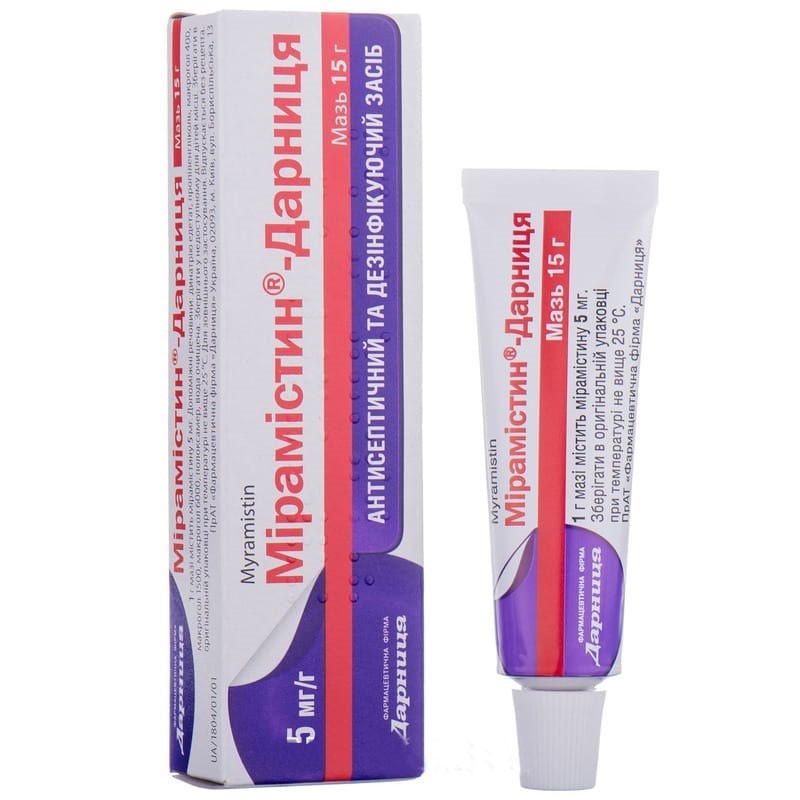



 Secure and encrypted payment processing
Secure and encrypted payment processing We ship to over 40 countries including the USA, UK, Europe, Australia and Japan
We ship to over 40 countries including the USA, UK, Europe, Australia and Japan Guaranteed refund or reship if you haven't received your order
Guaranteed refund or reship if you haven't received your orderMiramistin - the active pharmaceutical ingredient of the drug - refers to the surfactants of the cationic class. Due to its chemical structure, the compound interacts with the lipid layer of the bacterial wall, which leads to the destruction of the membrane of the microorganism.
The range of action of miramistin is wide and diverse. The pronounced bactericidal effect of miramistin is noted when exposed to gram-positive cocci (staphylococcus and streptococci, including pneumococci) and gram-negative pathogens. Miramistin is characterized by high activity against microorganisms of both aerobic and anaerobic types, which form and do not form spores, as well as to large viruses (for example, herpes).
Miramistin has fungicidal properties. Dermatophytes, yeast and fungi of the genus Candida, ascomycetes, the causative agent of pityriasis, and others are sensitive to it.
Of great interest is the activity of miramistin in relation to associations of microorganisms and multiresistant nosocomial strains, as well as an increase in the sensitivity of antibiotic-resistant strains during its use.
Studies have shown a significant inhibitory effect of miramistin on the formation of biofilms and the already existing biofilms of microorganisms such as Staphylococcus aureus and group A β-hemolytic streptococcus.
Local exposure to miramistin leads to increased regeneration of damaged tissues, improves the effect of treating chronic wounds.
The wide range of antimicrobial action of miramistin determines the highly effective prevention of contamination of skin lesions (wounds, burns) during its use. The distinct hyperosmolar effect of miramistin prevents the development of the inflammatory process in the wound and near-wound area. Due to this property, purulent exudate is eliminated, selective dehydration of dead tissue with the formation of a dry scab is noted. Along with this, granulation tissue and healthy skin cells are not damaged, and the processes of marginal epithelization are not inhibited.
Pharmacokinetics The ointment base of the drug, due to its physical and chemical characteristics, affects the pathogens of infection, which are located both on the surface of the wound and in the tissues of the near-wound area. Thus, it is likely that a small amount of the active substance will enter the blood.
For topical use in adult patients.
Therapy of wounds and burn injuries. The drug is distributed directly over the area of damaged skin, pre-treated by conventional methods. Then, a sterile gauze dressing is applied to the damaged treated area. It is possible to apply the ointment first to the material for dressing, and then to the wound.
It is possible to fill cavities of surgically treated purulent wounds or fistulous passages with ointments soaked in ointments or gauze turundas.
In the inflammatory phase, the ointment is used 1 time per day, in the regeneration phase, the frequency of use is reduced to 1 time in 1-3 days (depending on the state of the wound).The dose of the drug is determined by the volume of the lesion and the severity of purulent exudation. The speed of the process of cleansing the wound and repairing damaged tissue affects the duration of therapy.
Infection of deep-seated soft tissues requires the use of systemic antibiotics combined with miramistin, which determines the overall duration of therapy.
Application in dermatology. Ointment is distributed 1-2 times a day with a layer of small thickness on the affected skin or on the material for dressing with further application to damaged areas. Therapy should be continued until negative microbiological results are obtained. In the case of extensive damage to the skin with dermatophytes, the use of an ointment with miramistin for 5-6 weeks in combination with griseofulvin (or systemic fungicidal agents) is allowed. The presence of onychomycosis requires prior detachment of the affected nail plates.
Hypersensitivity to miramistin or other components of the drug.
Occasionally, therapy with burns and trophic ulcers may be accompanied by a slight burning sensation. this effect quickly disappears (within 15–20 s) spontaneously without the use of painkillers or discontinuation of the drug.
Hypersensitivity reactions are also likely to occur (inter alia, rash, itching, hyperemia, dryness, dermatitis, maceration of the skin). The presence of propylene glycol in the preparation can lead to irritation of the skin.
Irrigation of the surface of a wound with a solution with antimicrobial properties before applying an ointment to it increases the effectiveness of the drug.
In the case of wound contents of a purulent necrotic nature, an increase in the volume of ointment used is necessary.
Since there is no significant data on the use of the drug during pregnancy and lactation, before using it in this category of patients, a doctors consultation is necessary.
The drug is not used in children.
Miramistin ointment does not affect the reaction rate when driving vehicles and working with equipment.
The combined topical use of surface-active substances of the anionic class with miramistin reduces its activity.
Miramistin enhances the sensitivity of microorganisms to antibiotics when used in combination with drugs of this group.
No cases of overdose have been identified. Nevertheless, in the case of the distribution of the ointment with miramistin over a large area of the skin, penetration of the active ingredients into the blood is possible. however, their number does not lead to toxic effects.
The systemic effect of miramistin is characteristic of surfactants of the cationic class, an increase in the bleeding period is possible.
Therapeutic measures for overdose include canceling treatment or reducing the dose of the drug. Apply calcium preparations per os, Vicasol.
At a temperature of ≤25 ° C in the original packaging.